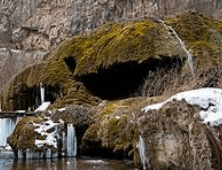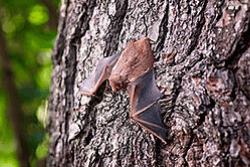 Did you know? Many animals hibernate through the winter to make the most out of scarce resources and survive the cold weather. While most people associate hibernating with bears, other small animals such as bats also hibernate through the winter months. Another misconception is that hibernating animals sleep solidly throughout their entire hibernation period. In some bat species, particularly in temperate-zone bats, hibernation occurs in cycles with periods of rest and periods of consciousness. This blog post will shed light onto the hidden world of the hibernating bats — how they survive even with very limited resources and how they endure the cold weather.
Did you know? Many animals hibernate through the winter to make the most out of scarce resources and survive the cold weather. While most people associate hibernating with bears, other small animals such as bats also hibernate through the winter months. Another misconception is that hibernating animals sleep solidly throughout their entire hibernation period. In some bat species, particularly in temperate-zone bats, hibernation occurs in cycles with periods of rest and periods of consciousness. This blog post will shed light onto the hidden world of the hibernating bats — how they survive even with very limited resources and how they endure the cold weather.
What is hibernation?
Hibernation is a period of widespread physiological changes in animals that allows them to survive the extreme conditions brought by the winter season. Hibernation includes an extended period of deep sleep or torpor along with a suppressed metabolism or dormancy. When a species hibernates their metabolic rate reduces, their body temperature drops, their heart rate slows down, and there are prolonged pauses between their breaths to values lower than the average Basal Metabolic Rate (BMR).
Hibernation has a seasonal connotation since it occurs in response to a drop in ambient temperatures, lower food supply and darkness that naturally comes with the winter months.  On the other hand, hibernation during summer months is referred to as aestivation, where vertebrate and invertebrate animals enter a lowered metabolic state to prevent dehydration in response to high temperatures and arid conditions.
On the other hand, hibernation during summer months is referred to as aestivation, where vertebrate and invertebrate animals enter a lowered metabolic state to prevent dehydration in response to high temperatures and arid conditions.
Where and how do bats hibernate?
Temperate-zone bats either migrate to warmer temperatures or hibernate at the onset of the winter season. Most bats that don’t migrate will hibernate in shelters called hibernacula. While caves and mines are the most commonly known hibernacula for bats, tree-roosting bats almost never enter caves and can be found hibernating in hollow trees or other sheltered places such as attics. Additionally, some species of bats such as eastern red bats (Lasiurus borealis) are known to hibernate in leaf litter on the forest floor. As mentioned in my previous blog posts, whether roosting or hibernating, bats choose their every potential habitat depending on the shelter it provides and more importantly, its ambient temperature.
Bats induce torpor by substantially slowing down their metabolism, and lowering their core body temperature. The average body temperature of a bat will drop from around 108° F to the ambient temperature of the hibernation site, typically 39° F – 59° F. The heart rate slows from over 1,000 beats per minute when in flight, to one beat every 4-5 seconds during hibernation.  Their metabolism is so reduced that a hibernating bat can survive on only a few grams of stored fat during the entire 5-6 month period and will end up losing 25% – 50% of its pre-hibernation body weight.
Their metabolism is so reduced that a hibernating bat can survive on only a few grams of stored fat during the entire 5-6 month period and will end up losing 25% – 50% of its pre-hibernation body weight.
Bats hibernate singularly or in large clusters. Clusters can consist of more than 400 bats per square foot, which can look like the picture to the left of clustered Indiana bats (Myotis sodalis). Other species, like the big brown bat (Episticus fuscus) hibernate individually.
Do all bats hibernate?
Typically only bat species that occur in areas that experience cold winters and a significant drop in insect activity hibernate. Bat species in tropical environments usually feed on fruit and active insects all year and do not need to take time off.
Temperatures and environmental factors typically do not trigger a metabolic response among bats. However, other bats such as hoary bats (Lasiurus cinereus) and Mexican free-tailed bats (Tadarida brasiliensis mexicana) prefer to migrate to hundreds or even thousands of miles to warmer climates in the southern U.S. and Mexico rather than hibernate for the winter.
As mentioned earlier hibernation occurs due to a seasonal change in the environment and is used as a survival technique.
Why is it important NOT to disturb hibernacula?
Due to their inactivity during hibernation, bats are very susceptible to sudden biotic and abiotic changes to their hibernacula. Since bats greatly reduce their BMR, sudden changes can be disastrous as bats are not quick to adapt or maneuver to a new location. As such, humans should be wary when entering a potential bat hibernacula, particularly caves with clusters of hibernating bats. The slightest disturbance to bat hibernacula can disrupt their hibernation and the sensitive physiological cycles that are occurring inside their bodies. Disrupting hibernation among bats can reduce their chance to survive the winter.
For example, humans can suddenly rouse hibernating bats if they go spelunking in a cave that serves as a hibernaculum. If hibernating bats suddenly unexpectedly wake up, their hearts will struggle to beat to normal rates; their bodies will strive to raise their temperatures to normal levels; and might even push them to hastily scrounge for food.
Additionally, the disease White Nose Syndrome (WNS) is known to afflict hibernating bats that cluster together and can be passed to unaffected sites by human cross contamination. Visitors to potential hibernacula should be careful not to bring or spread the fungus that causes WNS.
What can YOU do to help hibernating bats this holiday season?
To help protect your sleeping furry friends, consult with local wildlife professionals before entering a potential hibernation site. If you suspect that your home, business or project site may contain hibernating bats or potential hibernacula, consult a FirstCarbon Solutions (FCS) biologist to find out how to reduce potential impacts to bats such as installing exclusion doors to bat entrances.
FCS’ team of experienced biologists and sustainability experts can complete comprehensive Environmental Assessments and reliable Natural Resources Management that will help reduce negative impacts on wildlife surrounding businesses, projects, and homes. Talk to the FCS experts today to find out more about preserving wildlife species in your area.





